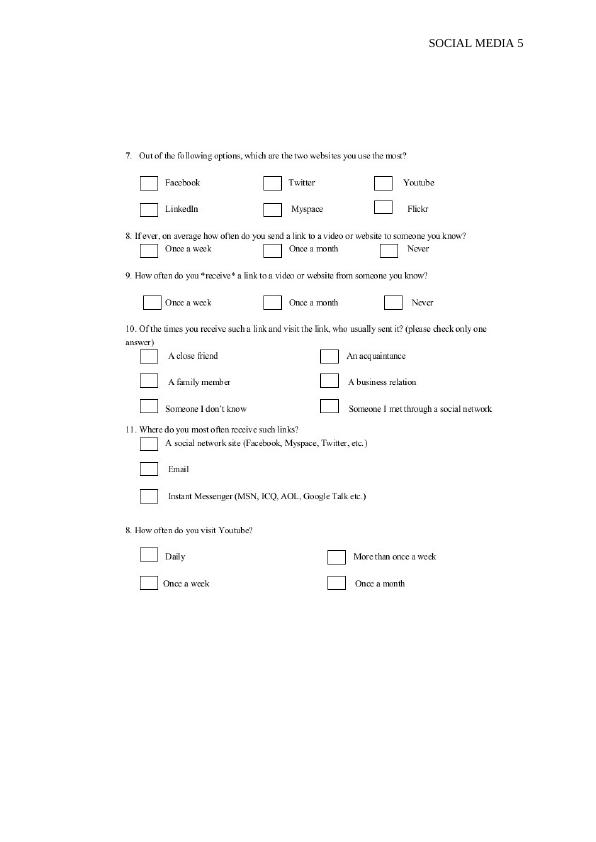Research Aims and Objectives Analysis Report
Added on 2022-08-14
52 Pages14253 Words16 Views
Running head: SOCIAL MEDIA
Impact of social media on impulse buying - Clothing specified
[Name of the Student]
[Name of the Institute]
[Date]
Impact of social media on impulse buying - Clothing specified
[Name of the Student]
[Name of the Institute]
[Date]
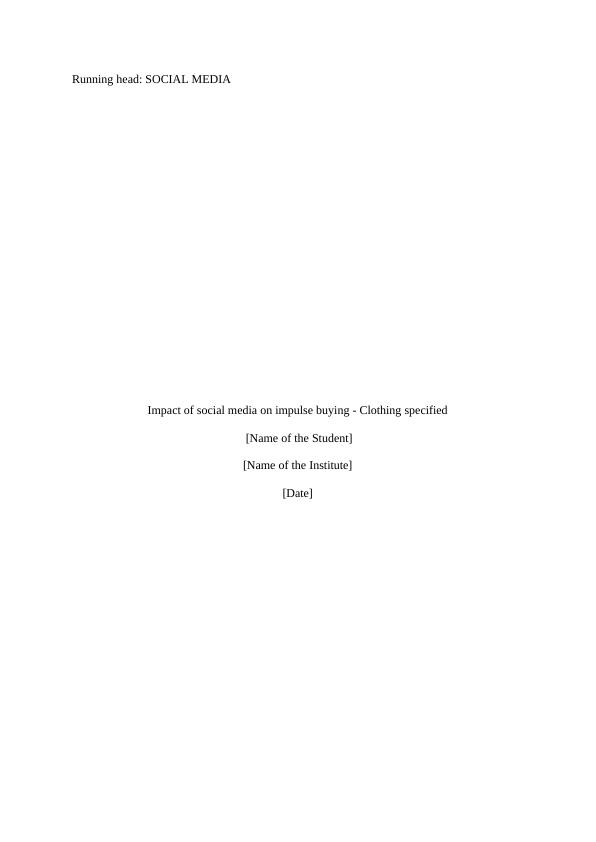
SOCIAL MEDIA 2
Table of Contents
CHAPTER 1: INTRODUCTION..............................................................................................6
Background of the Study........................................................................................................6
Purpose of the Study...............................................................................................................7
Significance of the Study........................................................................................................8
Research Aims and Objectives...............................................................................................8
Research Question..................................................................................................................9
CHAPTER 2: LITERATURE REVIEW.................................................................................10
Definition of Impulse Buying...............................................................................................10
Conceptual Definitions of Impulse Buying..........................................................................10
Analysis of impulsive buying behaviour..........................................................................11
Suggestion Impulse Buying..............................................................................................16
Operational Definitions of impulse buying..........................................................................17
Antecedents of Impulse Buying...........................................................................................18
Personal Traits..................................................................................................................20
Culture..............................................................................................................................21
Behavioural Intentions......................................................................................................22
Hedonic Consumption Tendency........................................................................................23
Social Surroundings..........................................................................................................24
Consumer Involvement.....................................................................................................25
Product Categories............................................................................................................26
Theoretical Framework........................................................................................................27
Impulse Buying Model.........................................................................................................27
Fashion-Oriented Impulse Buying Model............................................................................29
S-O-R Model........................................................................................................................30
The Stimulus-Organism........................................................................................................31
Hypotheses..........................................................................................................................32
CHAPTER 3: METHODOLOGY...........................................................................................34
Data Collection.....................................................................................................................34
Instrumentation.....................................................................................................................35
Data Analysis Technique......................................................................................................36
Structural Equation Modelling (SEM).................................................................................37
The goodness of Model Fit...............................................................................................38
Handling Missing Data.........................................................................................................39
Table of Contents
CHAPTER 1: INTRODUCTION..............................................................................................6
Background of the Study........................................................................................................6
Purpose of the Study...............................................................................................................7
Significance of the Study........................................................................................................8
Research Aims and Objectives...............................................................................................8
Research Question..................................................................................................................9
CHAPTER 2: LITERATURE REVIEW.................................................................................10
Definition of Impulse Buying...............................................................................................10
Conceptual Definitions of Impulse Buying..........................................................................10
Analysis of impulsive buying behaviour..........................................................................11
Suggestion Impulse Buying..............................................................................................16
Operational Definitions of impulse buying..........................................................................17
Antecedents of Impulse Buying...........................................................................................18
Personal Traits..................................................................................................................20
Culture..............................................................................................................................21
Behavioural Intentions......................................................................................................22
Hedonic Consumption Tendency........................................................................................23
Social Surroundings..........................................................................................................24
Consumer Involvement.....................................................................................................25
Product Categories............................................................................................................26
Theoretical Framework........................................................................................................27
Impulse Buying Model.........................................................................................................27
Fashion-Oriented Impulse Buying Model............................................................................29
S-O-R Model........................................................................................................................30
The Stimulus-Organism........................................................................................................31
Hypotheses..........................................................................................................................32
CHAPTER 3: METHODOLOGY...........................................................................................34
Data Collection.....................................................................................................................34
Instrumentation.....................................................................................................................35
Data Analysis Technique......................................................................................................36
Structural Equation Modelling (SEM).................................................................................37
The goodness of Model Fit...............................................................................................38
Handling Missing Data.........................................................................................................39
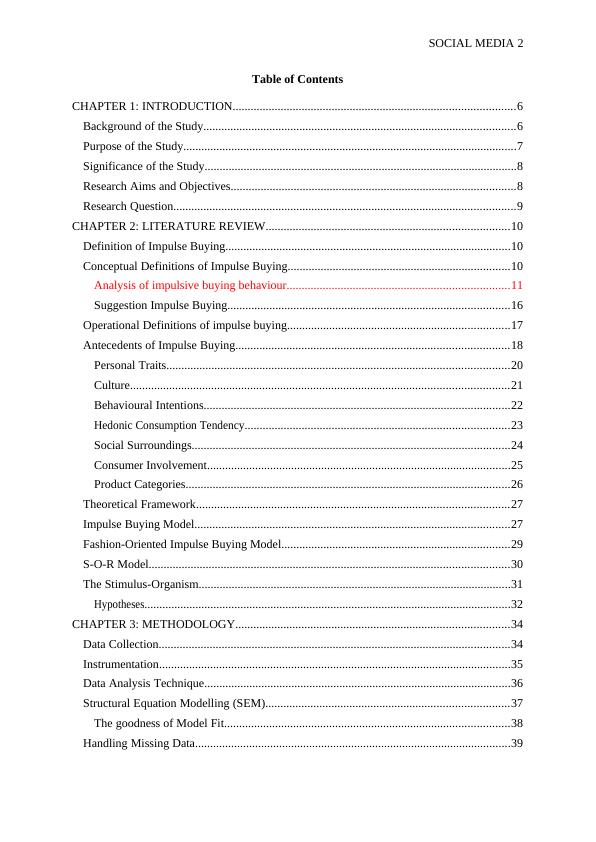
SOCIAL MEDIA 3
CHAPTER 4: RESULTS.........................................................................................................40
Sample Characteristics.........................................................................................................40
Factor Analysis....................................................................................................................42
Model Fit...........................................................................................................................44
Assumptions for SEM..........................................................................................................45
Hypothesis Testing...........................................................................................................46
CHAPTER 5: CONCLUSION.................................................................................................49
References................................................................................................................................50
CHAPTER 4: RESULTS.........................................................................................................40
Sample Characteristics.........................................................................................................40
Factor Analysis....................................................................................................................42
Model Fit...........................................................................................................................44
Assumptions for SEM..........................................................................................................45
Hypothesis Testing...........................................................................................................46
CHAPTER 5: CONCLUSION.................................................................................................49
References................................................................................................................................50


SOCIAL MEDIA 7
CHAPTER 1: INTRODUCTION
Background of the Study
Motivating buying is a big part of buyer behaviour and a basic idea in the mall. The
importance of unit purchases was first recognized by motivated buying specialists who
discovered numerous unit purchases in retail stores in the 1950s where 5% of purchases were
incentive purchases in an explicit store. In contrast, estimates for normal purchases were from
Units for each of the 19 business types examined were 21.8%. It showed that 36.8% of
purchases in the food, drug, and range and retail chain were motivating. As wages for
consumer goods and access to credit increased, motivation to buy increased and impulse
buying became the dominant behaviour of customers. Around 40% of buyers were classified
as motivating buyers and motivation to buy. "Accounted for up to 80% of all purchases in
certain article categories. In 2001, more than 50% of shopping in shopping centres was
motivating. With unit purchases having a significant commitment to store offerings, retailers
have contributed to impressive efforts to increase motivation when shopping in-store,
packaging items, and limited-time in-store devices shop (Aragoncillo & Orús, 2018a).
While retailers can provide stimulation to motivate purchases, impulse buying cannot
be looked at as an inappropriate behaviour that the buyers should refrain from. In a large
variety of buyer demographic, impulse buying has been noticed as a common behavioural
pattern. Impulse buying or impulse purchasing refers to an unplanned decision made to buy a
product or a service on an instantaneous basis. It means that the buyers usually make the
decision to buy that product or service moments before the actual purchase is done. A number
of research has indicated that impulse buying is closely associated with a wide variety of
feelings and emotions attached to the purchase of the service or the product. In order to
facilitate that feeling, sellers tend to promote the product either through enhancement of the
product’s visual appeal, connected with a well-articulated and targeted promotional message.
CHAPTER 1: INTRODUCTION
Background of the Study
Motivating buying is a big part of buyer behaviour and a basic idea in the mall. The
importance of unit purchases was first recognized by motivated buying specialists who
discovered numerous unit purchases in retail stores in the 1950s where 5% of purchases were
incentive purchases in an explicit store. In contrast, estimates for normal purchases were from
Units for each of the 19 business types examined were 21.8%. It showed that 36.8% of
purchases in the food, drug, and range and retail chain were motivating. As wages for
consumer goods and access to credit increased, motivation to buy increased and impulse
buying became the dominant behaviour of customers. Around 40% of buyers were classified
as motivating buyers and motivation to buy. "Accounted for up to 80% of all purchases in
certain article categories. In 2001, more than 50% of shopping in shopping centres was
motivating. With unit purchases having a significant commitment to store offerings, retailers
have contributed to impressive efforts to increase motivation when shopping in-store,
packaging items, and limited-time in-store devices shop (Aragoncillo & Orús, 2018a).
While retailers can provide stimulation to motivate purchases, impulse buying cannot
be looked at as an inappropriate behaviour that the buyers should refrain from. In a large
variety of buyer demographic, impulse buying has been noticed as a common behavioural
pattern. Impulse buying or impulse purchasing refers to an unplanned decision made to buy a
product or a service on an instantaneous basis. It means that the buyers usually make the
decision to buy that product or service moments before the actual purchase is done. A number
of research has indicated that impulse buying is closely associated with a wide variety of
feelings and emotions attached to the purchase of the service or the product. In order to
facilitate that feeling, sellers tend to promote the product either through enhancement of the
product’s visual appeal, connected with a well-articulated and targeted promotional message.
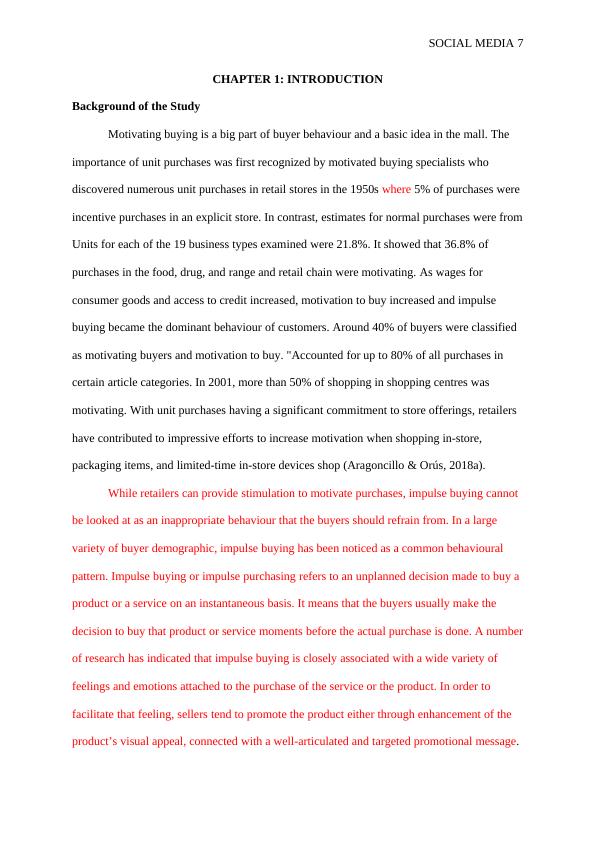
SOCIAL MEDIA 8
At the same time, it is not prudent to confuse impulse purchase with urgent purchase.
(Xiang et al., 2016) separated the types of purchases by motivation and characterized urgent
purchases as a kind of constant and irregular expenditure, which is described by an
astonishing and sad will to buy. They argued that the purchase of shares was specific to the
usual purchase since the purchase of shares was promoted by external triggers (e.g. advance
sales) and impulse purchases were persuaded by internal triggers (e.g. nervousness,
excitement, irresistible desire to own a product or engage a service). While the impulses of
impulse purchases emanate from Epicurean desires, for example, passion and pleasure, which
are not hurtful, impulse purchases are reflected in the main purchases and expenses, which
often achieve dangerous results. The financial importance of motivated shopping cannot be
overstated. The economy would weaken if people went into town to shop exactly when they
expected something, or if customers bought exactly what they needed during a shopping
spree. The wording describes the "Next" or "To Buy" purchase options as usual and the
expected customer practices, and includes suggestions on how to create the conditions of the
store to stimulate purchases (Gudonavičienė & Alijošienė, 2015). This is where promotion
for the purpose of impulse buying or purchasing become relevant. Ensuring that the correct
message regarding the product reaches the correct customer base plays a crucial role in
actively promoting impulse buying in people. The one domain where most of the customer
base can successfully be reached, therefore becomes social media. The primary objective of
this study is to measure the connection between social media use and impulse buying,
looking at how the customers get intrigued by the various promotional tactics of social media
marketing and engage in impulse purchase.
Purpose of the Study
The motivation behind this research was to develop a logical model of impulse
buying, which tends to be the forerunner of motivational buying. To achieve this objective,
At the same time, it is not prudent to confuse impulse purchase with urgent purchase.
(Xiang et al., 2016) separated the types of purchases by motivation and characterized urgent
purchases as a kind of constant and irregular expenditure, which is described by an
astonishing and sad will to buy. They argued that the purchase of shares was specific to the
usual purchase since the purchase of shares was promoted by external triggers (e.g. advance
sales) and impulse purchases were persuaded by internal triggers (e.g. nervousness,
excitement, irresistible desire to own a product or engage a service). While the impulses of
impulse purchases emanate from Epicurean desires, for example, passion and pleasure, which
are not hurtful, impulse purchases are reflected in the main purchases and expenses, which
often achieve dangerous results. The financial importance of motivated shopping cannot be
overstated. The economy would weaken if people went into town to shop exactly when they
expected something, or if customers bought exactly what they needed during a shopping
spree. The wording describes the "Next" or "To Buy" purchase options as usual and the
expected customer practices, and includes suggestions on how to create the conditions of the
store to stimulate purchases (Gudonavičienė & Alijošienė, 2015). This is where promotion
for the purpose of impulse buying or purchasing become relevant. Ensuring that the correct
message regarding the product reaches the correct customer base plays a crucial role in
actively promoting impulse buying in people. The one domain where most of the customer
base can successfully be reached, therefore becomes social media. The primary objective of
this study is to measure the connection between social media use and impulse buying,
looking at how the customers get intrigued by the various promotional tactics of social media
marketing and engage in impulse purchase.
Purpose of the Study
The motivation behind this research was to develop a logical model of impulse
buying, which tends to be the forerunner of motivational buying. To achieve this objective,
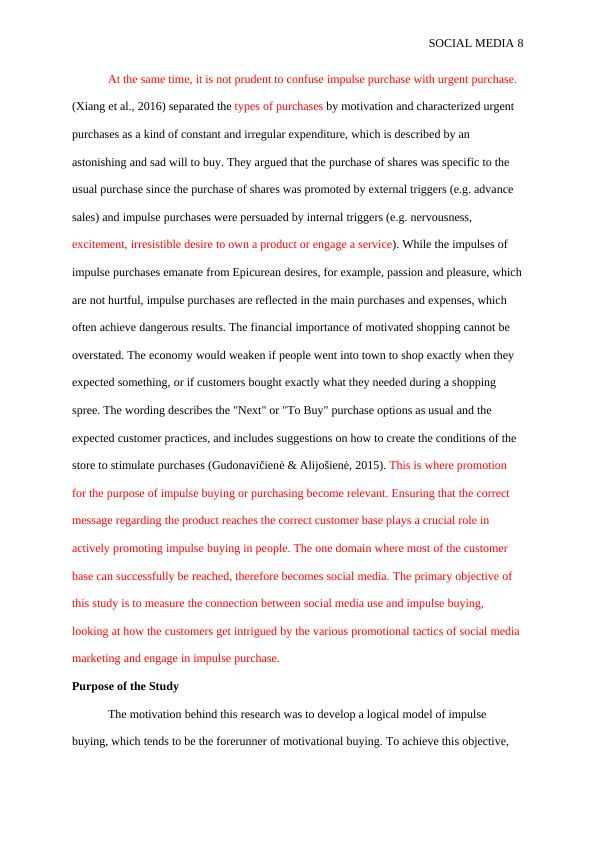
End of preview
Want to access all the pages? Upload your documents or become a member.
Related Documents
Impulsive Buying Behavior Research Report 2022lg...
|88
|19870
|6
Factors Affecting Online Shopping of Thai Students at University of Northamptonlg...
|52
|12514
|107
A Study Of The Structure And Function Of The................................................................................................................3 1.3.1. General Objectives 5 1.3.2. Specifilg...
|51
|17075
|164
Customer Behaviour Influence on Grocery Store Purchasing Decisionslg...
|77
|24562
|34
A STUDY TO ANALYZE THE IMPACT OF CUSTOM MADE APPAREL ON CUSTOMER SATISFACTIONlg...
|43
|10383
|293
Consumer buying behaviour.lg...
|9
|468
|57


